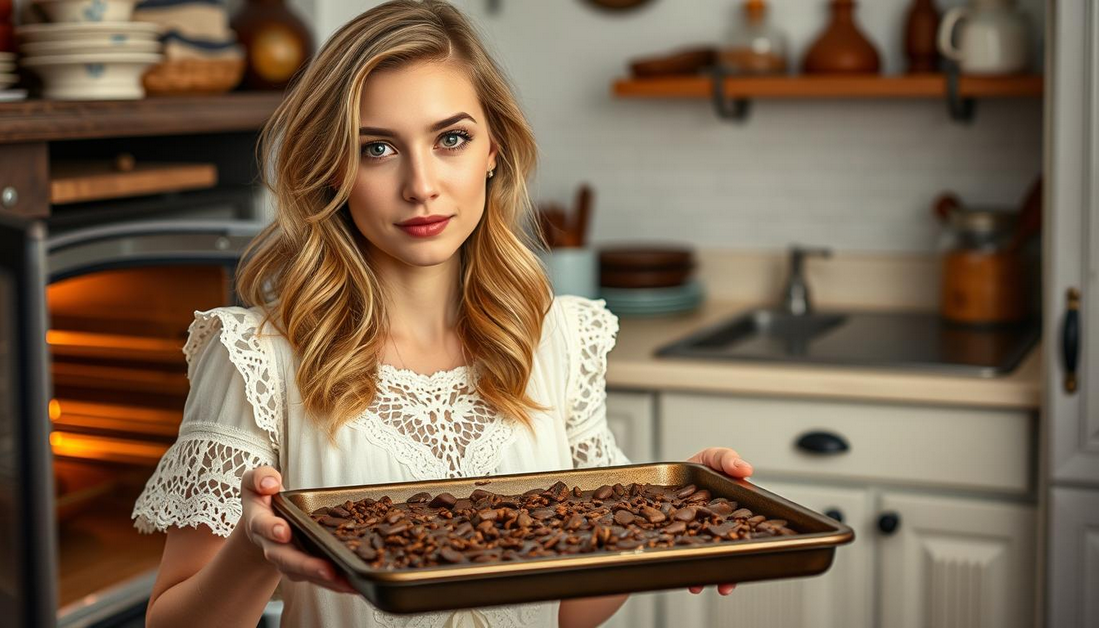India customers to view on amazon.in
Step-by-Step Chocolate Kunafa Made at Home
Indulge in the rich flavors of the Middle East with a dessert that’s both decadent and surprisingly easy to make: chocolate kunafa. This beloved dessert, traditionally filled with cheese or cream, gets a luxurious twist with the addition of chocolate, making it a perfect treat for any occasion.
- The Magic of Chocolate Kunafa
- Traditional Kunafa vs. Chocolate Variation
- Essential Ingredients for Perfect Homemade Chocolate Kunafa
- Why This Middle Eastern Dessert Is Perfect for Any Occasion
- The Rich History of Kunafa
- Modern Twist: Enter the Chocolate Kunafa
- How to Make Chocolate Kunafa at Home
- Step-by-Step Recipe: Making Chocolate Kunafa
- Step 1: Prepare the Sugar Syrup
- Step 2: Prepare the Chocolate Filling
- Step 3: Work with the Kataifi Dough
- Step 4: Layer the Kunafa
- Step 5: Bake the Kunafa
- Step 6: Add the Sugar Syrup
- Serving Suggestions
- Popular Variations To Try
- Nutella Chocolate Kunafa
- Dark Chocolate with Sea Salt
- White Chocolate & Raspberry Kunafa
- Chocolate & Cream Cheese Kunafa
- Mini Chocolate Kunafa Cups
- Tips for Perfect Chocolate Kunafa
- Healthier Alternatives for Guilt-Free Indulgence
- Using Dark Chocolate and Less Sugar
- Swapping Butter with Ghee or Coconut Oil
- Bonus Tips for a Healthier Kunafa Experience
- Conclusion
- FAQ
- What is kunafa, and how does the chocolate version differ from the traditional one?
- Can I use different types of chocolate for the filling?
- What kind of vermicelli noodles are best for making kunafa?
- Can I make kunafa ahead of time, and if so, how do I store it?
- How do I achieve the perfect crunchy exterior and creamy chocolate filling?
- Can I customize the kunafa recipe with nuts or other toppings?
- Is kunafa suitable for special occasions like Eid or other celebrations?

Making homemade chocolate kunafa is a straightforward process that requires just a few ingredients and some basic kitchen tools. The result is a crispy, golden pastry filled with a gooey, chocolatey center that’s sure to impress.
Key Takeaways
- Easy to make with simple ingredients
- Rich, chocolatey filling in a crispy pastry
- Perfect for special occasions or everyday treats
- Customizable with different types of chocolate
- A unique twist on a traditional Middle Eastern dessert
The Magic of Chocolate Kunafa
Chocolate Kunafa is more than just a dessert; it’s an experience that blends tradition with innovation. This Middle Eastern dessert has been a staple for centuries, and its transformation with chocolate has made it a contemporary favorite.
Traditional Kunafa vs. Chocolate Variation
Traditional Kunafa is made with shredded phyllo dough, cheese, and syrup, offering a sweet and savory taste. The chocolate variation adds a rich, velvety chocolate filling, creating a chocolate fusion dessert that’s both familiar and excitingly new. This twist doesn’t just appeal to chocolate lovers; it elevates the traditional Kunafa to a new level, making it a hit for anyone looking to try something different.
Essential Ingredients for Perfect Homemade Chocolate Kunafa
To make a delicious homemade kunafa, you’ll need a few essential ingredients. Start with vermicelli noodles, which are the base of this dessert with vermicelli. You can find them at most Middle Eastern or Asian grocery stores. For the kunafa with chocolate, use high-quality chocolate, such as Ghirardelli or Lindt, to give it a rich flavor.
The filling is another crucial component. A traditional choice is akkawi cheese, but you can experiment with other types of cheese or add nuts for a different twist. To achieve a crispy kunafa recipe, bake it in the oven until golden brown. The oven baked kunafa is a great alternative to deep-frying.
For the syrup, a simple mixture of sugar, water, and rose water or orange blossom water will do. You can adjust the amount of syrup to your taste. With these easy kunafa recipe ingredients, you’ll be well on your way to creating a mouth-watering chocolate cheese kunafa or chocolate layered dessert. Experiment with different kunafa filling ideas to make it your own, and enjoy your step by step kunafa creation.

Why This Middle Eastern Dessert Is Perfect for Any Occasion
Kunafa, whether traditional or with chocolate, is a versatile dessert perfect for any gathering. Here are a few reasons why:
- It’s easy to make at home with a simple kunafa recipe.
- The combination of crunchy and creamy textures is universally appealing.
- It’s a great middle eastern dessert to introduce to friends and family who love trying new foods.
By making kunafa at home and adding your twist, such as a chocolate filling, you can customize it to suit any occasion, from casual get-togethers to formal events.
The Rich History of Kunafa
Kunafa—also known as kanafeh or knafeh—is a time-honored dessert with deep roots in the Middle East and Eastern Mediterranean. Thought to have first emerged during the 10th-century Fatimid Dynasty, it quickly became a beloved delicacy in regions such as Palestine, Lebanon, Jordan, Turkey, and Egypt. Traditionally crafted using shredded phyllo dough (kataifi), generously soaked in aromatic sugar syrup and filled with creamy cheese or semolina custard, kunafa earned its place as a staple of celebrations and generous hospitality.
Through the years, this crisp, syrup-infused delight has evolved, crossing cultural borders and adapting to new tastes. Whether served during Ramadan or as a highlight at joyous events like weddings, kunafa holds sentimental value tied to tradition. Recently, however, modern chefs and dessert enthusiasts have taken this classic to innovative levels—with the luxurious addition of chocolate transforming it into a new-age favorite.
Modern Twist: Enter the Chocolate Kunafa
The rise of fusion cuisine has brought with it a delightful innovation—chocolate kunafa. A modern take on the traditional dish, chocolate kunafa replaces or complements the classic cheese or cream fillings with rich, molten chocolate. This version is especially popular among younger audiences and chocolate lovers who crave a dessert that’s both crispy and indulgent.
This decadent twist retains the essence of kunafa’s crisp and syrupy texture while introducing the deep, luxurious flavor of chocolate. Whether made with dark, milk, or even white chocolate, this version adds an irresistible element to an already beloved dessert.

How to Make Chocolate Kunafa at Home
Chocolate kunafa is a modern, mouthwatering twist on the classic Middle Eastern dessert. Traditionally filled with cheese or cream, kunafa (also spelled kanafeh or knafeh) has been delighting taste buds for centuries. But in recent years, the chocolate version has taken the dessert world by storm. With its crispy, golden exterior and rich, molten chocolate filling, this treat is a perfect fusion of tradition and indulgence.
Whether you’re looking to impress guests, celebrate a special occasion, or simply satisfy a late-night craving, chocolate kunafa is a dessert worth mastering. Here’s everything you need to know about making chocolate kunafa at home—from ingredients and tools to step-by-step instructions, variations, and expert tips.
Ingredients You’ll Need
For the Kunafa Base
- 250 grams of kataifi dough (shredded phyllo dough)
- 100 grams of unsalted butter (melted) or ghee
For the Chocolate Filling
- 200 grams of high-quality chocolate (dark, milk, or a mix)
- 100 ml heavy cream (optional, for ganache-style filling)
For the Sugar Syrup (Qatar)
- 1 cup sugar
- ½ cup water
- 1 teaspoon lemon juice
- 1 teaspoon rose water or orange blossom water (optional for flavor)
Optional Garnishes
- Crushed pistachios or hazelnuts
- Cocoa powder
- A scoop of ice cream or whipped cream
Tools You’ll Need
- A non-stick round baking pan (8–9 inch) or muffin tin (for mini kunafa)
- A silicone brush (for spreading butter)
- Mixing bowls
- Saucepan
- Whisk or spatula
- Grater or food processor (if needed for chopping chocolate)

Step-by-Step Recipe: Making Chocolate Kunafa
Step 1: Prepare the Sugar Syrup
Start with the syrup so it has time to cool.
- In a small saucepan, combine sugar and water.
- Bring to a gentle boil over medium heat, then add lemon juice.
- Let it simmer for 5–7 minutes until it slightly thickens.
- Turn off the heat and stir in rose water or orange blossom water, if using.
- Set aside to cool.
This syrup will be poured over the kunafa once it’s baked, giving it that sweet, glossy finish.
Step 2: Prepare the Chocolate Filling
You have two options here:
A. Simple Melted Chocolate
- Chop the chocolate finely and set aside. You’ll sprinkle it directly into the kunafa layers before baking.
B. Chocolate Ganache (more decadent)
- Heat the cream until just boiling, then pour it over chopped chocolate.
- Stir until smooth and glossy. Let it cool slightly before using.
Ganache makes the center of your kunafa creamier and more luxurious.
Step 3: Work with the Kataifi Dough
- Gently pull apart the kataifi dough and fluff it using your hands. If it’s frozen, thaw completely before using.
- Pour melted butter or ghee over the dough and mix thoroughly until evenly coated.
- Make sure the strands are soft, moist, and fully separated.
This ensures even crisping and a rich buttery flavor.

Step 4: Layer the Kunafa
In a greased pan:
- Press half the kataifi dough into the base of the pan. Use the back of a spoon or your fingers to flatten and compact it.
- Add your chocolate filling over the base—either sprinkle chopped chocolate evenly or spoon ganache over.
- Top with the remaining dough, pressing down gently to seal in the filling.
If making mini kunafa, follow the same process using muffin tins for individual servings.
Step 5: Bake the Kunafa
- Preheat your oven to 180°C (350°F).
- Place the kunafa pan in the center rack and bake for 25–30 minutes, or until golden brown and crispy on top.
- Keep an eye on the color—it should be a beautiful deep golden, not overly browned.
Step 6: Add the Sugar Syrup
- Once out of the oven, immediately pour the cooled sugar syrup over the hot kunafa.
- Do this slowly to allow even absorption. The sizzle as it hits the hot dough is a great sign!
Let the kunafa rest for 5–10 minutes before cutting or serving to allow the syrup and chocolate to settle perfectly.

Serving Suggestions
Chocolate kunafa is best served warm, allowing the chocolate center to remain gooey and luxurious. Consider pairing with:
- A scoop of vanilla or rose ice cream
- A sprinkle of crushed pistachios or almonds
- A drizzle of extra chocolate or caramel sauce
- A light dusting of cocoa powder for a dramatic finish
Popular Variations To Try
Nutella Chocolate Kunafa
Flavor Profile: Creamy, nutty, and indulgently sweet
Nutella’s iconic hazelnut-cocoa flavor blends beautifully with kunafa’s crispy, buttery strands. The warmth of baked kataifi melts the Nutella inside, creating a gooey, luxurious center that complements the crisp exterior.
Perfect For: Hazelnut lovers, children’s parties, or anyone seeking a rich, comforting dessert with familiar, crowd-pleasing appeal.
Tip: Layer Nutella generously between two layers of kunafa dough and drizzle with warm sugar syrup for the perfect finish.
Dark Chocolate with Sea Salt
Flavor Profile: Bitter-sweet richness with a touch of saltiness
Dark chocolate’s intensity is beautifully balanced by a pinch of sea salt, cutting through the sweetness of the syrup and dough. This variation is perfect for adults who enjoy deeper, more refined dessert flavors.
Perfect For: Dinner parties or those who enjoy gourmet desserts with a modern twist.
Tip: Use 70% or higher cocoa content for a bold flavor, and finish with flaky sea salt on top after baking.

White Chocolate & Raspberry Kunafa
Flavor Profile: Sweet, tart, and buttery with a creamy finish
White chocolate provides smooth sweetness while raspberries add a tangy contrast. The blend of flavors creates a visually striking and palate-pleasing combination, making this a favorite during spring or festive events.
Perfect For: Brunches, romantic occasions, or those seeking a colorful twist on a classic.
Tip: Mix chopped raspberries with white chocolate pieces or ganache, and keep the syrup lighter (maybe even flavored with rose water).
Chocolate & Cream Cheese Kunafa
Flavor Profile: Rich and slightly tangy with smooth chocolate layers
This variation pairs the sweetness of chocolate with the slight tang of cream cheese, reminiscent of a cheesecake texture—but wrapped in crispy, golden kataifi. The cream cheese adds body and balances the chocolate’s richness.
Perfect For: Those who love fusion desserts and want a filling that feels luxurious and velvety.
Tip: Soften the cream cheese and blend it with chocolate chips or ganache. Use a thicker layer for more contrast.
Mini Chocolate Kunafa Cups
Flavor Profile: All the flavor in bite-sized portions
These individual kunafa cups are easy to serve, ideal for sharing, and perfect for customizing. The crispy shell and molten chocolate center make them irresistible in just a few bites.
Perfect For: Gifting, parties, potlucks, or dessert platters.
Tip: Use a muffin tray to shape the kunafa nests and fill each with chocolate ganache, Nutella, or a flavored chocolate mix. Bake until golden and crisp.

Tips for Perfect Chocolate Kunafa
Freshness is key when working with kataifi dough. Always use fresh dough to prevent it from drying out or crumbling during preparation. If it’s frozen, make sure it’s fully thawed and fluffed before use.
The quality of your chocolate makes a big difference. Opt for high-quality chocolate—whether it’s dark, milk, or white—for a smoother melt, richer taste, and better texture.
Baking time can vary depending on your oven and tray depth, so instead of relying solely on the clock, keep an eye on the color. A golden brown top and lightly crisp edges are your signs to pull it out.
For the perfect syrup soak, timing and temperature matter. Drizzle the syrup over the kunafa while it’s still hot out of the oven, but ensure the syrup itself is cool. This temperature contrast helps the kunafa absorb the sweetness without becoming soggy.
Finally, kunafa is best enjoyed right after baking. Serving it fresh ensures you get that delightful contrast between the crispy outer layer and the gooey, melted chocolate center inside.
Serving Suggestions for Chocolate Kunafa
Pairing with Beverages
Chocolate kunafa, with its rich layers and crispy golden crust, is made even better with the right drink by its side. Choosing a beverage that complements the sweetness and texture of this dessert can elevate the experience entirely.
- Arabic Coffee (Qahwa): The subtle bitterness and spiced aroma of traditional Arabic coffee balances the dessert’s sweetness beautifully. Its cardamom notes enhance the chocolate’s depth.
- Mint Tea: A refreshing glass of mint tea cuts through the richness of the kunafa, cleansing the palate between bites.
- Chilled Milk or Iced Lattes: Whether it’s plain milk or a light iced latte, the cooling effect pairs perfectly with the warm, gooey center of the dessert.
- Hot Chocolate with a Hint of Orange or Cinnamon: For a luxurious dessert moment, pair chocolate kunafa with a spiced hot chocolate, adding warmth and seasonal flair.
- Espresso or Cappuccino: For coffee lovers, the bold notes of an espresso or a creamy cappuccino bring out the chocolate tones while contrasting the sweet syrup.
You can even get creative with fusion drinks like saffron lattes, rose milk, or cardamom-infused almond milk for a Middle Eastern twist.

Healthier Alternatives for Guilt-Free Indulgence
Indulging in chocolate kunafa doesn’t have to come with a side of guilt. With a few mindful substitutions and tweaks, you can enjoy this decadent dessert while keeping it lighter and more suitable for various dietary goals. Whether you’re cutting down on sugar, looking for dairy-free options, or simply want a better balance between taste and nutrition, here are some smart and satisfying alternatives:
Using Dark Chocolate and Less Sugar
Traditional chocolate kunafa often relies on sweet milk chocolates and heavy syrup, but opting for dark chocolate can significantly reduce sugar content while enhancing flavor.
- Go for 70% Cocoa or Higher: Dark chocolate with at least 70% cocoa contains less sugar and more antioxidants, making it a heart-healthy option. It also adds depth and slight bitterness that balances beautifully with the sweet kunafa dough.
- Control the Sweetness with Syrup: Instead of saturating the kunafa in syrup, lightly drizzle it. You can also make your own syrup using less sugar, and infuse it with orange blossom water, rose water, or a squeeze of lemon for a fragrant touch.
- Try Natural Sweeteners: Replace refined sugar with alternatives like honey, maple syrup, coconut sugar, or stevia in the syrup. These options often have a lower glycemic index and add subtle flavor variations.
By choosing better-quality chocolate and using syrup more sparingly, you can create a version of kunafa that feels indulgent but doesn’t overwhelm your system with sugar.
Swapping Butter with Ghee or Coconut Oil
Butter lends richness to traditional kunafa, but there are healthier fat options that not only reduce saturated fat intake but also bring added flavor dimensions.
- Ghee (Clarified Butter): Ghee is a great substitute for butter as it contains no milk solids, making it suitable for lactose-sensitive individuals. It’s also rich in healthy fats and lends a nutty, aromatic flavor that pairs beautifully with Middle Eastern desserts. Plus, it enhances the crispness of kataifi dough without greasiness.
- Coconut Oil: For a plant-based twist, unrefined cold-pressed coconut oil works wonderfully. It adds a slight coconut essence that complements chocolate especially well. Coconut oil is also known for its medium-chain triglycerides (MCTs), which are considered easier to digest and may offer metabolic benefits.
- Olive Oil (For a Light Version): If you’re seeking a more neutral and heart-healthy fat, light-tasting extra virgin olive oil can also be used in small amounts. It offers antioxidants and monounsaturated fats, but use it sparingly to avoid overpowering the dessert.
These swaps reduce cholesterol-heavy fats while retaining the luxurious texture kunafa is known for.
Bonus Tips for a Healthier Kunafa Experience
- Portion Control: Serve smaller portions or make mini kunafa bites to satisfy sweet cravings without overindulgence.
- Add Nuts for Texture & Nutrition: Incorporate crushed pistachios, almonds, or walnuts into the filling or as a garnish. They add crunch, fiber, and healthy fats.
- Use Whole-Grain Kataifi Dough (If Available): While rare, some artisan shops offer whole-grain phyllo or kataifi dough. It increases fiber content and adds a more rustic texture.
- Skip the Food Coloring: Traditional kunafa often includes orange food dye—opt out for a more natural appearance and clean ingredient list.
Conclusion
Chocolate kunafa is a beautiful fusion of traditional Middle Eastern textures and rich, velvety chocolate indulgence. Whether you’re drawn to its crisp, buttery layers or its gooey, molten center, this dessert is guaranteed to impress. From its historic roots to its modern-day reinventions, chocolate kunafa has evolved into a global favorite that brings warmth and elegance to any table.
With simple ingredients and a few creative twists, you can easily recreate this decadent dessert at home—whether you stick to the classic version or try a healthier spin. By understanding its key components, mastering baking techniques, and customizing it to suit your taste, chocolate kunafa becomes more than just a dish—it becomes an experience worth sharing.
FAQ
What is kunafa, and how does the chocolate version differ from the traditional one?
Kunafa is a popular Middle Eastern dessert made with vermicelli noodles, typically filled with cheese or cream, and soaked in syrup. The chocolate version replaces the traditional cheese or cream filling with a rich chocolate filling, adding a delightful twist to the classic dessert.
Can I use different types of chocolate for the filling?
Yes, you can experiment with various types of chocolate, such as dark, milk, or white chocolate, to create different flavor profiles. You can also mix and match different chocolates for a unique taste.
What kind of vermicelli noodles are best for making kunafa?
Look for high-quality, thin vermicelli noodles that are specifically designed for making kunafa. You can find these noodles at most Middle Eastern or Asian grocery stores.
Can I make kunafa ahead of time, and if so, how do I store it?
Yes, you can prepare kunafa ahead of time. Once baked, let it cool completely, then store it in an sealed container at room temperature for up to a day. You can also refrigerate or freeze it for longer storage. Reheat it in the oven before serving.
How do I achieve the perfect crunchy exterior and creamy chocolate filling?
To achieve the perfect texture, make sure to bake the kunafa until it’s golden brown and crispy. For the chocolate filling, use high-quality chocolate and don’t overmix it, so it retains its creaminess.
Can I customize the kunafa recipe with nuts or other toppings?
Absolutely! You can customize your kunafa with various toppings, such as chopped nuts, shredded coconut, or even caramel sauce, to give it a personal touch.
Is kunafa suitable for special occasions like Eid or other celebrations?
Kunafa is a popular dessert in the Middle East, often served during special occasions like Eid. The chocolate version is a great twist on the traditional dessert, making it perfect for any celebration or gathering.







